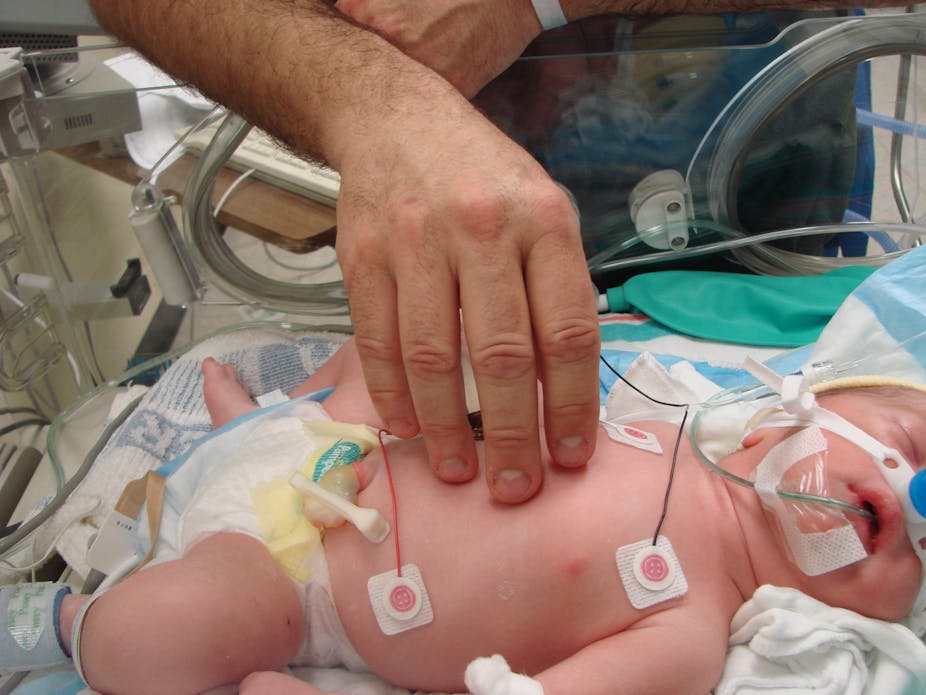Australia has high rates of medical and surgical intervention (including caesarean section) during birth, especially in private hospitals.
While these interventions can be harmful if overused, people working in the private sector have argued they’ve resulted in better health for babies. Research we have just published using a large population-based sample shows this is not so.
Birth interventions include labour being induced, the mother being given an epidural (anaesthetic in the spine for pain relief), birth by caesarean section, the use of forceps or a suction cup (vacuum birth) on the baby’s head for delivery, and a surgical cut to the perineum (episiotomy) to make the vaginal opening wider.
Such interventions should only be used where there’s a medical need (if either the mother or the baby is unwell, for instance, or the birth is taking too long). And since they create new risk, women should be told about the benefits and risks of the intervention before it takes place.
High intervention rates
In 2012, we published research showing low-risk women having their baby in private hospitals in New South Wales had much higher rates of obstetric intervention than those giving birth at a public hospital.
Expecting mothers are categorised as low risk if they are under 35 years of age, have a full-term baby (37 to 42 weeks) with normal birth weight, don’t smoke and have no medical or obstetric complications. These latter include high blood pressure, diabetes, and previous caesarean section, twins or breech birth, among other things.
Looking at data from 2000 to 2008, we found only 15% of low-risk first time mothers in private hospitals had a normal vaginal birth without intervention compared to 35% in public hospitals. Overall, first-time mothers had a 20% lower chance of having a normal birth in private hospitals compared to public hospitals.
When we published our findings, privately-practising obstetricians defended their intervention rate, recognising it was high but noting it was worth doing to save babies’ lives. This makes perfect sense but we wanted to know whether there was any evidence for this position.
Seeking evidence
The result was a paper we’ve just published in BMJ Open. For this research, we looked again at low-risk women giving birth in New South Wales between 2000 and 2008.

But this time, we examined problems that required medical attention following birth and readmission to hospital within the first 28 days of life as well as the rate of intervention at birth. We also looked at stillbirths and infant deaths up to 28 days following birth.
We found babies born in private hospitals were more likely to be born before 40 weeks gestation (as they are more likely to have their labour induced or have an elective caesarean section before 40 weeks) and they were more likely to have some form of resuscitation at birth.
They were also more likely to have a problem following birth and to be readmitted to hospital in their first 28 days for birth trauma (mostly scalp trauma) (5% vs 3.6%); hypoxia (lack of oxygen during birth) (1.7% vs 1.2%); jaundice (4.8% vs 3%); feeding difficulties (4% vs 2.4%); sleep or behavioural issues (0.2% vs 0.1%); breathing problems (1.2% vs 0.8%) and circumcision (5.6% vs 0.3%).
All except the last of these may be associated with higher rates of medical intervention. They also lead to a longer stay in hospital following birth, and separation of mother and child.
Most significantly, there was no difference in the death rates between babies born in the two types of hospitals.
Disempowering mothers
But why had the obstetricians responding to our 2012 report thought their higher rates of intervention had been saving babies’ lives? Part of the reason may be a 2009 paper that concluded better health for babies born in private Australian hospitals.
Unfortunately, this research had only looked at one data set (we looked at five) and did not control for important risk factors, such as low birth weight which can lead to more deaths and medical problems in the baby.
And there is an even bigger problem with wider ramifications here. A recent Queensland study showed a significant number of pregnant women are not consulted in decision-making about the medical procedures they undergo, or informed of their risks and benefits.
This can lead to trauma and feelings of disempowerment about the birth. It may also impact how mothers connect with their newborn baby. Some women are so traumatised, they become depressed and even develop post traumatic stress disorder. In some cases, women choose to birth at home next time with or without a midwife in attendance (freebirth).
Women about to give birth should question interventions to assess whether they’re necessary. For those with low-risk healthy pregnancies, private obstetric care in a private hospital, with their higher rates of intervention may be leading to avoidable health problems for their babies.

